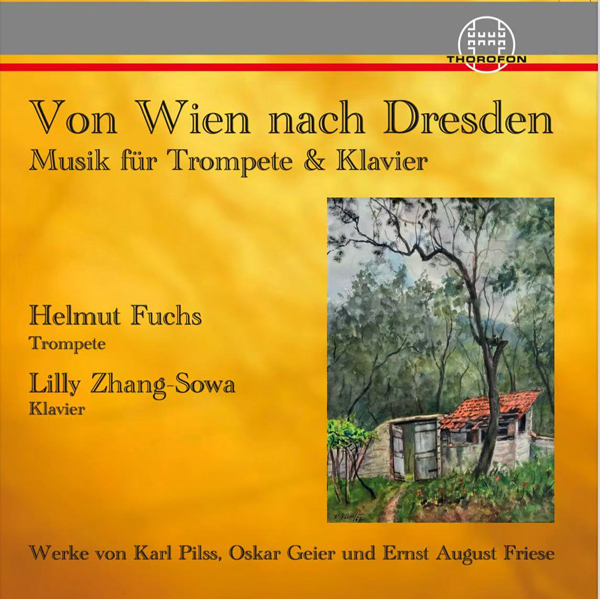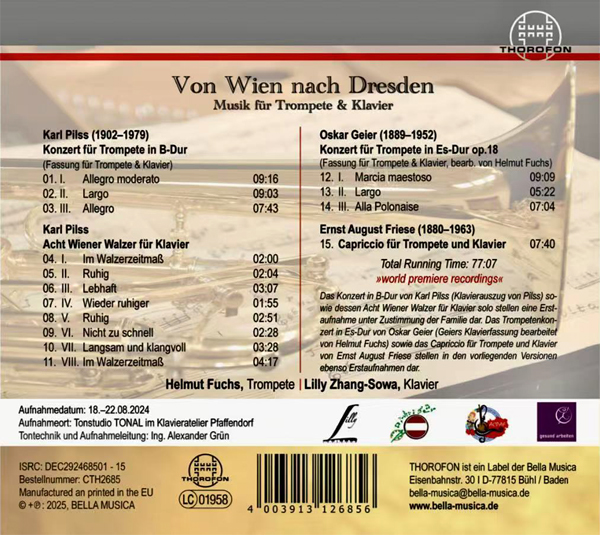鉴碟:“从维也纳到德累斯顿”挖掘“遗失的宝藏”
乙巳年开年,德累斯顿国家管弦乐团首席小号赫尔默特·福斯特先生携手长期合作伙伴钢琴家Lilly Zhang-Sowa女士再次为乐迷奉上一张极具欣赏性和文献价值的唱片。

如果说德累斯顿国家管弦乐团是当今最能代表德奥之声的交响乐团活化石,那么两位艺术家在题为“从维也纳到德累斯顿”的唱片里,用最德奥的声音,为浪漫主义后期几部被遗忘的经典,做出了最“纯粹”,最“维也纳”(Viennese style)的诠释。
在Lilly Zhang-Sowa女士和福斯特先生的精心安排下,唱片的选曲围绕两大古典音乐名城以及作曲家们与巨擘理查·施特劳斯的奇特渊源为纽带,自成有机的一体。小册子Booklet详实地梳理了德奥晚期浪漫派的流变,不仅让爱乐者知晓作品背景,更了然艺术家音乐处理和风格把握的内在原由。
唱片以卡尔·皮尔斯(Karl Pilss)的B大调小号协奏曲开篇,钢琴缩谱由作曲家本人完成,本张专辑对该作品的收录填补了皮尔斯作品的一大空白。也自然成为揭开皮尔斯小号奏鸣曲中些许谜团的重要参考。
皮尔斯为钢琴而作的“八首维也纳华尔兹”是本张专辑的一大亮点。Lilly女士充分展示自己句法和音色上的天赋,并成功地向听众展示了作品中隐藏的理查·施特劳斯的烙印。
同时收录于本专辑的奥斯卡·吉尔(Oskar Geier)降e大调小号协奏曲(独奏家赫尔默特编曲)以及恩斯特·奥古斯特·福瑞斯(Ernst August Friese)的随想曲也皆为小号作品库里几乎被遗忘的佳作。
赫尔默特的音色温暖、干净,对速度的把控也非常合理,并没有将作品带入炫技的漩涡,而是从容地把所有技术段落唱了出来。作曲家Pilss一贯对合唱及声乐作品的创作情有独钟,赫尔默特出色地把握这一特点,尤其在二乐章高音区的弱奏令人赞叹。吉尔协奏曲中,赫尔默特充分展示了自己在装饰音上的能力,行云流水,给人自然舒适之感。而随想曲中高贵的音色以及对长句子的把控,或许会让福瑞斯的作品成为众多小号演奏者未来独奏会的选择。

Album Review: "From Vienna to Dresden" Unearths "Lost Treasures"
Li Rui
At the beginning of the Year of the Snake, Mr.Helmut Fuchs, the principal trumpet of the Dresden Staatskapelle, alongside his long-time collaborator, pianist Lilly Zhang-Sowa, once again presents music enthusiasts with a highly appreciable and historically significant album.
If the Dresden Staatskapelle is regarded as the living fossil of the symphony orchestra that best represents the German-Austrian
sound today, then the two artists, in their album titled "From Vienna to Dresden," offer the most "pure" and "Viennese-style" interpretations of several forgotten late Romantic masterpieces.
Under the meticulous arrangement of Ms.Lilly Zhang-Sowa and Mr.Helmut Fuchs, the album’s selection of pieces revolves around the two classical music capitals, Vienna and Dresden, and the unique connections between the composers and the giant Richard Strauss, forming an organic whole. The booklet provides a detailed account of the evolution of late German-Austrian Romanticism, not only enlightening music lovers about the background of the works but also offering insights into the artists’ musical interpretations and stylistic choices.
The album opens with Karl Pilss’s Trumpet Concerto in B major, with the piano reduction completed by the composer himself. The inclusion of this piece fills a significant gap in Pilss’s oeuvre and serves as an important reference for unraveling some of the mysteries in his trumpet sonatas.
Pilss’s "Eight Viennese Waltzes for Piano" stands out as a highlight of the album. Ms. Lilly fully showcases her talent in phrasing and tonal expression, successfully revealing the hidden traces of Richard Strauss in the works.
Also featured in this album are Oskar Geier's Trumpet Concerto in E-flat Major (arranged by soloist Helmut) and Ernst August Friese's Capriccio, both of which are nearly forgotten gems in the trumpet repertoire.
Helmut's tone is warm and pure, with a masterful control of tempo that avoids the trap of mere virtuosity, instead delivering each technical passage with grace. Composer Pilss has always had a special affinity for choral and vocal compositions, and Helmut captures this essence beautifully, particularly in the delicate high notes of the second movement, which are truly remarkable. In the Geier Concerto, Helmut fully showcases his prowess with ornamentation, flowing effortlessly and creating a sense of natural ease. The noble timbre and command of long phrases in the Capriccio might well make Friese's work a future favorite for many trumpet soloists in their recitals.




